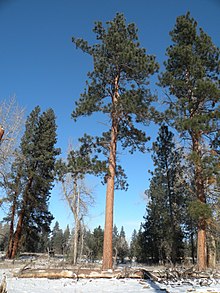Flora of the Colorado Plateau and Canyonlands region
The flora of the Colorado Plateau and Canyonlands region is generally characterized by plant adaptations to the arid conditions of the region, and a wide variation of plant communities from wide variations in elevation and soil types.
Plant communities
Salt desert shrub community
The salt desert shrub is a
Blackbrush scrub community
Blackbush scrub,
Sand desert shrub community
The sand desert shrub (SDS) is a
Mixed desert shrub community
Mixed desert shrub is a
Pinyon juniper woodland community
The pinyon–juniper plant community covers a large portion of
Mountain brush community
Mountain brush is a
Ponderosa pine forest
The Jeffrey pine and the ponderosa pine are common in drier montane areas of the
Jeffrey pine is more stress tolerant than ponderosa pine in the Sierra Nevada. At higher elevations, on poorer (including

Ponderosa pine forests occurs on the Colorado Plateau[7] and in the Sierra Nevada[8] of the Western United States, as well as other parts of North America.
One way to distinguish between them is by their cones. Each has barbs at the end of the scales. The sharp Jeffrey pine cone scale barbs point inward, so the cone feels smooth to the palm of one's hand when rubbed down the cone. Ponderosa pine cone scale barbs point outward, so feel sharp and prickly to the palm of one's hands. Another distinguishing characteristic is that the needles of Jeffrey pine are glaucous, less bright green than those of ponderosa pine, and by the stouter, heavier cones with larger seeds and inward-pointing barbs.[9]
Jeffrey pine wood and ponderosa pine wood are sold together as yellow pine.
References
- ^ ISBN 978-0-7627-7013-7
- ^ a b c Mojave Desert Wildflowers, Pam Mackay, p18, 252
- ^ a b c Canyon Country Wildflowers, Damian Fagan, p 3, 105
- ^ Hiking Grand Staircase-Escalante & the Glen Canyon Region, 2nd ed, Ron Adkison
- ^ Damian Fagan, Canyon Country Wildflowers, p. 3
- ^ a b c Safford, H.D. (2013). "Natural Range of Variation (NRV) for yellow pine and mixed conifer forests in the bioregional assessment area, including the Sierra Nevada, southern Cascades, and Modoc and Inyo National Forests" (PDF). Vallejo, CA: USDA Forest Service, Pacific Southwest Region.
- ISBN 978-0-7627-7013-7.
- ISBN 0-520-06922-6.
- ISBN 978-1-4027-3875-3.
- ^ a b "Jeffrey Pine". The Wood Database.
